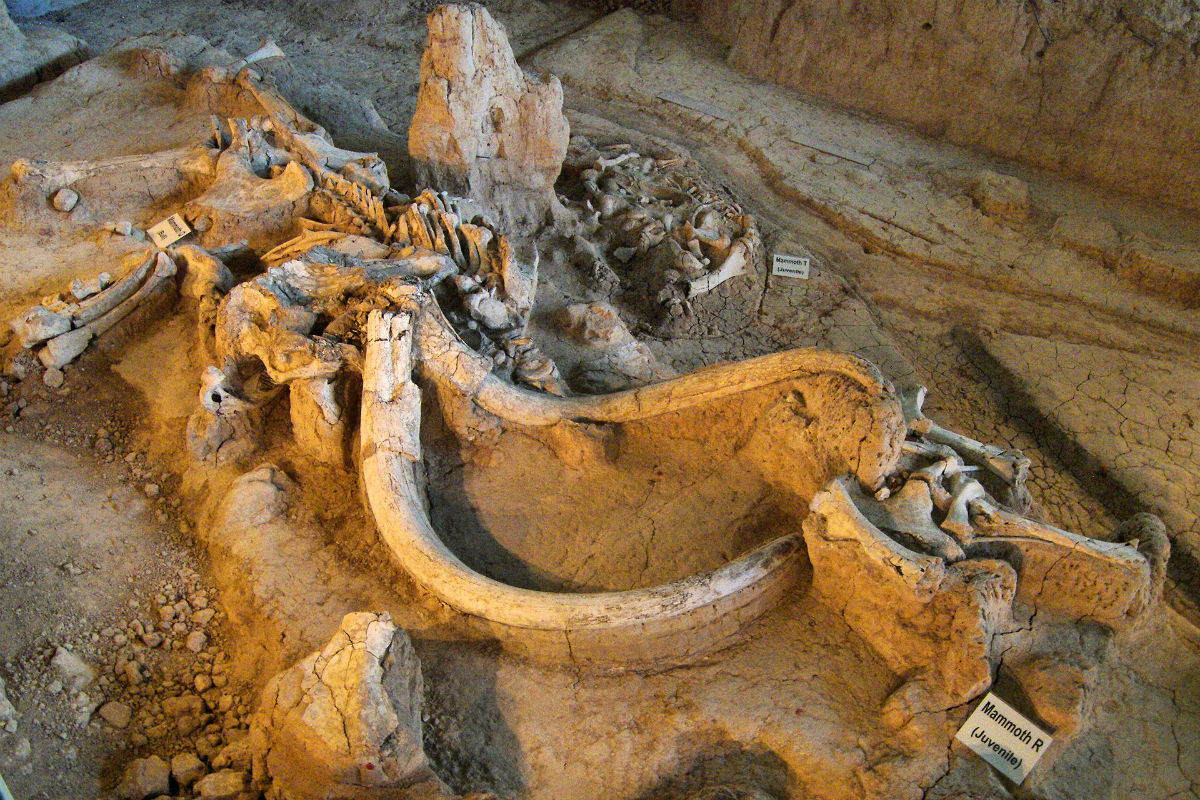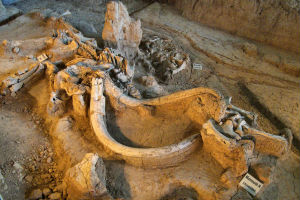
WACO, Texas (AP) – It might be ancient history, but the question of what killed the Waco mammoths has unearthed strong feelings about 65,000 years later.
The Waco Tribune-Herald reports a recent Baylor University study suggesting that the beasts at the Waco Mammoth National Monument might have died of drought rather than flood has raised the hackles of the man who oversaw the excavation of the bones years ago.
Now Calvin Smith, retired director of Baylor’s natural history museum, is officially challenging the study. He recently sent a 2,200-word rebuttal to the journal Palaios, which published the original December article by Baylor doctoral students Logan Wiest and Don Esker and geology professor Steven Driese.
The Baylor team found marks of hide beetles on the mammoth bones, suggesting that the carcasses were exposed to open air for months, not covered up in a catastrophic mudslide as researchers had thought for decades.
In his response, Smith doesn’t address the hide beetle evidence but argues that a mammoth herd slowly dying of thirst would have dispersed.
“There would have been no mass burial as we found them,” he wrote. “Under the conditions proposed by the authors, the deaths would not have been simultaneous for the number represented and would have been over an extended period.”
Smith adds that the mammoths were found in an upright “sudden death syndrome” position, suggesting they were trapped in a sudden flood.
Smith served as the director of the Strecker Museum, which has since become the Mayborn Museum, from 1983 to 2003, long before the mammoth site was developed as an educational tourist attraction and ultimately adopted into the national park system in 2015.
Smith, 76, a Colorado resident, said he learned about the new study from a Tribune-Herald story in January. In an interview, he said he was surprised that the researchers would have tried to rewrite the prehistory of the mammoth site without consulting him to see what he knew about how the excavation was handled.
“They are saying the circumstances are totally different from what we experienced over 18 years,” he said. “They’re throwing that out the window. That’s what upsets me. It’s not good science.
“To call a former researcher that has done the work is normal scientific investigation.”
Esker, the co-author of the new study and a former director of the mammoth site, said he had been advised against commenting on Smith’s challenge. Smith said he has met on the issue with Esker’s faculty adviser, Lee Nordt, a Baylor geologist and dean of the college of arts and sciences. Nordt did not immediately respond to interview requests for this story.
Driese, the geology professor who oversaw Esker and Wiest in their research, defended the methods as sound. Driese said the drought hypothesis is tentative, but research Esker is planning will help establish more information about the mammoths’ environmental conditions.
“I feel like we need to keep an open mind,” Driese said. “It’s just a hypothesis that needs more testing. But I do feel like Don Esker’s work is critical to addressing those questions. The nature of science is that it evolves over time and is always subject to new information and new interpretation.”
He said the study’s “clincher” was the discovery of tracks made by dermestid, or hide beetles, on the mammoth skeletons. The beetles, which still are common today, feed on dried, putrid tissue but don’t scavenge bones that are underground or underwater, he said.
Driese said the article was presented last month at a Geological Society of America meeting in San Antonio and was favorably received.
Steve Hasiotis, a geologist at the University of Kansas who attended that meeting and read the article, said he thinks the evidence of the dermestid beetles is persuasive.
“This looks like this wouldn’t have been underwater … I think the evidence is pretty strong that they were on the surface and then buried,” Hasiotis said.
Hasiotis’ specialty is ichnology, the study of fossil traces made by ancient organisms. He said he had a similar experience in the 1990s when he discovered dermestid beetle markings on dinosaur fossils in Utah and Wyoming, suggesting long exposure to the elements.
He said that conflicted with an earlier understanding of how those dinosaurs died, and it took a while for other scientists to accept it.
“The theory had been laid down, and it’s hard for things to change,” he said. “But science is not conducted by consensus. It’s by the evidence that really supports the story or does not falsify the hypothesis.”
In an interview, Smith said he’s not persuaded that the markings on the bones were from dermestid beetles. He said parts of the mammoth corpses could have been exposed even after they were buried. And in modern times, the bones were exposed for years under a tent at the mammoth site while it was being excavated, time enough to suffer damage from floods, scavengers and the excavation process itself, he said.
“You can blame me. We had no money. We were working with volunteers, and the bones were exposed for years,” Smith said. “Those bones were exposed to every single thing these boys are talking about: the collapse, breakage, gnawing, even the holes.”
Both Hasiotis and Driese say the marks on the bones are ancient in appearance and would not have resulted from modern-day scavengers or human error.
“I think there is no chance markings on bones were incorrectly attributed to scavenging,” Driese said. “There was nothing of nutritive value for varmints.”
Smith said scientists developed the flood hypothesis in the mid-1980s based on the concentration of mammoths in the pit and the fact they appeared to be in a standing position upon death.
Among the consultants during that time was Gary Haynes, an anthropologist then with the Smithsonian Institution. Haynes, who had studied modern elephants in Africa, concluded that the Waco mammoths comprised a nursery herd that was under severe environmental stress because of drought. He hypothesized that the group gathered around a watering hole and was covered up when a sudden storm washed mud downstream from denuded stream banks.
In a recent email interview, Haynes said he disagrees with the findings of the new Baylor study, though he hadn’t yet read it.
“A drought usually takes weeks to kill elephants, as they run out of forage to eat near their main water sources, and they must move farther and farther to find food patches and then regularly return to the last remaining sources of water,” he said. “By the time adult males die from starvation due to drought, the bones of the calves and older females will have been chewed by carnivores, trampled and scattered.
“I just don’t see how drought could have created an assemblage of associated and articulated mammoth skeletons (and a camel) at the Waco mammoth site.”
The new study cites past work by Haynes on the mammoth site.
Smith said he is glad Baylor researchers are continuing to study the mammoth remains, and he is open to new evidence.
“I don’t have a problem with them saying, ‘This is another scenario,'” he said.
Raegan King, site manager at the Waco Mammoth National Monument, said tour guides at the site now present both flooding and drought as a possible cause of the mammoths’ deaths. King agreed that the beetle markings indicate long exposure to the elements, though it’s possible the mammoths were buried, then exposed.
“We know for a fact that we have a herd that was well-preserved in the Texas clay,” she said. “Exactly what happened when these animals were here, we don’t know for sure.”
Regardless of the dispute, she said, attendance at the mammoth site continues to skyrocket. In the first 24 days of March, the site saw 12,535 visitors, twice the attendance of the previous period in 2016.
___
By J.B. SMITH, Waco Tribune-Herald
Information from: Waco Tribune-Herald, http://www.wacotrib.com
Copyright 2017 Associated Press. All rights reserved. This material may not be published, broadcast, rewritten, or redistributed.
AP-WF-04-12-17 1902GMT



